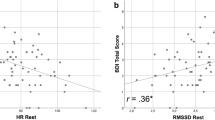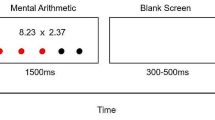Abstract
The study tested the prediction that the experience of life events would be reflected in greater autonomic reactivity and that this might play a moderating role between reported stress and psychological symptoms. Eighty-seven undergraduates were screened with a life events scale and thirty-nine were allocated to three groups representing high, medium, and low life event scores. The General Health Questionnaire, Profile of Mood States, the Spielberger Trait Anxiety Scale, and the Marlowe–Crowne Scale were administered. Electrodermal activity and heart rate were recorded during an habituation series of tones and a digit–symbol substitution task. The groups differed both on the GHQ and the POMS and, also, in their physiological responses to the tones. Unexpectedly, the high life event group, compared to the other groups, appeared to display smaller physiological responses. The cognitive task resulted in elevated physiological activity but no consistent group differences. Cardiovascular reactivity moderated the relationship between life event scores and reported distress. These findings are discussed in relation to theories of psychophysiological adaptation to negative events.
Similar content being viewed by others
REFERENCES
Adler, N., and Matthews, K. (1994). Health Psychology: Why do some people get sick and some stay well? Annu. Rev. Psychol. 45: 229-259.
Boucsein, W. (1992). Electrodermal Activity, Plenum Press, New York.
Boyce, W. T., and Chesterman, E. (1990). Life events, social support, and cardiovascular reactivity in adolescence. Dev. Behav. Pediatr. 11: 105-111.
Brown, J. D. (1991). Staying fit and staying well: Physical fitness as a moderator of life stress. J. Pers. Soc. Psychol. 60: 555-561.
Clements, K., and Turpin, G. (1996). The life event scale for students: Validation for use with British samples. Pers. Indiv. Diff. 20: 747-751.
Cohen, L. H., Simons, R. F., Rose, S. C., McGowan, J., and Zelson, M. F. (1986). Relationships among negative life events, physiological reactivity, and health symptomatology. J. Hum. Stress 12: 142-148.
Cook, E., and Turpin, G. (1997). Differentiating orienting, startle and defense responses: The role of affect and its implications for psychopathology. In Lang, P. J., Balaban, M., and Simons, R. (eds.) Attention and Orienting: Sensory and Motivational Processes, Erlbaum, Hillsdale, NJ, pp. 137-164.
Crandall, C. S., Preisler, J. J., and Aussprung, J. (1992). Measuring life event stress in the lives of college students: The undergraduate stress questionnaire (USQ). J. Behav. Med. 15: 627-662.
Creed, F. (1985) Life events and physical illness. J. Psychosom. Res. 29: 113-123.
Crowne, D. P., and Marlowe, D. (1964). The Approval Motive, John Wiley, New York.
DeLongis, A., Coyne, J. C., Dakof, G., Folkman, S., and Lazarus, R. S. (1982). Relationship of daily hassles, uplifts and major life events to health status. Health Psychol. 1: 119-136.
Dienstbier, R. A. (1989). Arousal and physiological toughness: Implications for mental and physical health. Psychol. Rev. 96: 84-100.
Finney, J. W., Mitchell, R. E., Cronkite, R. C., and Moos, R. H. (1984). Methodological issues in estimating main and interactive effects: Examples from coping/social support and stress field. J. Health Soc. Behav. 25: 85-98.
Flett, G. L., Blankstein, K. R., Hicken, D. J., and Watson, M. S. (1995). Social support and help-seeking in daily hassles versus major life events stress. J. Appl. Soc. Psychol. 25: 49-58.
Gale, A., and Edwards, J. A. (1986). Individual differences. In Coles, M. G. H., Donchin, E., and Porges, S. W. (eds.) Psychophysiology: Systems, Processes and Applications, Guilford Press, New York, pp. 431-507.
Gannon, L., Banks, J., Shelton, D., and Luchetta, T., (1989). The mediating effects of psychophysiological reactivity and recovery on the relationship between environmental stress and illness. J. Psychosom. Res. 33: 167-175.
Goldberg, D. (1978). Manual of the General Health Questionnaire, NFER-Nelson, Windsor.
Gorman, D. M. (1993). A review of studies comparing checklist and interview methods of data collection in life event research. Behav. Med. 19: 66-73.
Henriques, J. B., and Davidson, R. J. (1989). Affective disorder. In Turpin, G. (ed.) Handbook of Clinical Psychophysiology, Wiley, Chichester, pp. 357-392.
Herd, J. A. (1991). Cardiovascular response to stress. Psychol. Rev. 71: 305-329.
Hollis, J. F., Connett, J. E., Stevens, V. J., and Greenlick, M. R. (1990). Stressful life events, Type A behavior, and the prediction of cardiovascular and total mortality over six years. J. Behav. Med. 13: 263-280.
Holmes, D. S., and Roth, D. L. (1985). Association of aerobic fitness with pulse rate and Participantive responses to psychological stress. Psychophysiology 22: 525-529.
Hugdahl, K. (1995). Psychophysiology: TheMind-Body Perspective, Harvard University Press, Cambridge, MA.
Jorgensen, R. S., and Houston, B. K. (1989). Reporting of life events, family history of hypertension, and cardiovascular activity at rest and during psychological stress. Biol. Psychol. 28: 135-148.
Liang, S., Jemerin, J. M., Tschann, J. M., Irwin, C. E., Wara, D. W., and Boyce, W. T. (1995). Life events, cardiovascular reactivity, and risk behavior in adolescent boys. Pediatrics 96: 1101-1105.
Linden, W. (1984). Development and initial validation of a life event scale for students. Can. Counsel. 18: 106-110.
McEwen, B. S., and Stellar, E. (1993). Stress and the individual—mechanisms leading to disease. Arch. Int. Med. 153: 2093-2101.
McNair, D. M., Lorr, M., and Droppleman, L. F. (1981). Manual for the Profile of Mood States, Educational and Industrial Testing Service, San Diego.
McQuaid, J. R., and Monroe, S. M. (1992). Toward the standardization of life stress assessment: Definitional discrepancies and inconsistencies in methods. Stress Med. 8: 47-56.
Naveteur, J., and Freixa I Baque, E. (1987). Individual differences in electrodermal activity as a function of subjects' anxiety. Pers. Indiv. Diff. 8: 615-626.
Norman, R. M. G., and Malla, A. K. (1993). Stressful life events and schizophrenia I: A review of the research. Br. J. Psychiat. 162: 161-166.
Nuechterlein, K. H., Dawson, M. E., Ventura, J., Gitlin, M., Subotnik, K. L., Snyder, K. S., Mintz, J., and Bartzokis, G. (1994). The vulnerability/stress model of schizophrenic relapse: A longitudinal study. Acta Psych. Scand. 89(Suppl. 382): 58-64.
Nuechterlein, K. H., Goldstein, M. J., Ventura, J., Dawson, M. E., and Doane, J. A. (1989). Patient-environment relationships in schizophrenia: Information-processing, communication deviance, autonomic arousal and stressful life events. Br. J. Psychiat. 155(Suppl. 5): 84-89.
Nyklicek, I., Vingerhoets, J. J. M., and Van Heck, G. L. (1996). Hypertension and objective and self-reported stressor exposure: A review. J. Psychosom. Res. 40: 585-601.
Nyklicek, I., Vingerhoets, A. J. J. M., Van Heck, G. L., and Van Limpt, M. C. A. M. (1998). Defensive coping in relation to casual blood pressure and self-reported daily hassles and life events. J. Behav. Med. 21: 145-161.
Pardine, P., and Napoli, A. (1983). Physiological reactivity and recent life stress experience. J. Consult. Clin. Psychol. 51: 467-469.
Paykel, E. S., and Dowlatshahi, D. (1988). Life events and mental disorder. In Fisher, S., and Reason, J. (eds.), Handbook of Life Stress, Cognition and Health, John Wiley, Chichester, pp. 241-263.
Poulton, R. G., and Andrews, G. (1992). Personality as a cause of adverse life events. Acta Psychiatr. Scand. 85: 35-38.
Roth, D. L., and Holmes, D. S. (1985). Influence of physical fitness in determining the impact of stressful life events on physical and psychological health. Psychosom.Med. 47: 164-173.
Schaubroeck, J., and Ganster, D. C. (1993). Chronic demands and responsivity to challenge. J. Appl. Psychol. 78: 73-85.
Siegrist, J., and Klein, D. (1990). Occupational stress and cardiovascular reactivity in bluecollar workers. Work Stress 4: 295-304.
Spielberger, C. D., Gorsuch, R. L., and Lushene, R. E. (1970). Manual for the State-Trait Anxiety Inventory, Consulting Psychologists Press, Palo Alto, CA.
Steptoe, A., Wardle, J., Pollard, T. M., Canaan, L., and Davies, G. J. (1996). J. Psychosom. Res. 41: 171-180.
Tarrier, N., and Turpin, G. (1992). Psychosocial factors, arousal and schizophrenic relapse: The psychophysiological data. Br. J. Psych. 161: 3-11.
Tennant, C. (1996). Experimental stress and cardiac function. J. Psychosom. Res. 40: 569-583.
Theorell, T. (1992). Critical life changes. Psychother. Psychosom. 57: 108-117.
Turpin, G., and Clements, K. (1993). Electrodermal activity and psychopathology: The development of the palmar sweat index as an applied measure for use in clinical settings. In Roy, J. C., Boucsein, W., Fowles, D. C., and Gruzelier, J. (eds.), Electrodermal Activity: From Physiology to Psychology, Plenum Press, New York, pp. 49-60.
Turpin, G., and Lader, M. (1986). Life events and mental disorder: Biological theories of their mode of action. In Katschnig, H. (ed.), Life Events and Psychiatric Disorders: Controversial Issues, Cambridge University Press, Cambridge, pp. 33-62.
Unchino, B. N., Cacioppo, J. T., and Kiecoltglaser, J. K. (1996). The relationship between social support and physiological processess—A review with the emphasis on underlying mechanisms and implications for health. Psychol. Bull. 119: 488-531.
Van Eck, M., Berkhof, H., Nicolson, N., and Sulon, J. (1996). The effects of perceived stress, traits, mood states, and stressful daily events on salivary cortisol. Psychosom. Med. 58: 447-458.
Vingerhoets, A. D. J. J. M., Ratliff-Crain, J., Jabaaij, L., Menges, L. J., and Baum, A. (1996). Self-reported stressors, symptom complaints and psychobiological functioning 1: Cardiovascular stress reactivity. J. Psychom. Res. 40: 177-190.
Watson, D., and Pennebaker, J. W. (1989). Health complaints, stress and distress: Exploring the central role of negative affectivity. Psychol. Rev. 96: 234-254.
Wiebe, D. J., and Williams, P. G. (1992). Hardiness and health—A social psychophysiological perspective on stress and adaptation. J. Soc. Clin. Psychol. 11: 238-262.
Author information
Authors and Affiliations
Rights and permissions
About this article
Cite this article
Clements, K., Turpin, G. Life Event Exposure, Physiological Reactivity, and Psychological Strain. J Behav Med 23, 73–94 (2000). https://doi.org/10.1023/A:1005472320986
Issue Date:
DOI: https://doi.org/10.1023/A:1005472320986




